Advertisements
Advertisements
प्रश्न
How is potential gradient measured? Explain.
उत्तर १
Consider the following potentiometer, which is made up of a long uniform wire AB of length L and resistance R stretched on a wooden board and connected in series with a cell of stable emf E and internal resistance rand a plug key K.
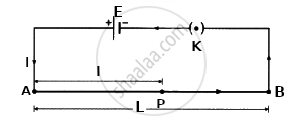
Let I be the current flowing through the wire when the circuit is closed.
Current through AB, I = `"E"/("R" + "r")`
Potential difference across AB. VAB = IR
∴ `"V"_"AB" = "ER"/("R + r")`
The potential difference (the fall of potential from the high potential end) per unit length of the wire,
`"V"_"AB"/"L" = "ER"/(("R + r")"L")`
As long as E and r remain constant, `"V"_"AB"/"L"` will remain constant. `"V"_"AB"/"L"` is known as a potential gradient along with AB and is denoted by K. As a result, the potential gradient is computed by dividing the potential difference between the ends of the potentiometer wire by the wire's length.
Let P be any point on the wire between A and B and AP = l = length of the wire between A and P.
Then `"V"_"AP" = "Kl"`
∴ `"V"_"AP" prop l` as K is constant in a particular case. Thus, the potential difference across any length of the potentiometer wire is directly proportional to that length. This is the principle of the potentiometer.
उत्तर २
- Potential gradient (K) is defined as a potential difference per unit length of wire.
- It is measured as, `"V"/"L" = "ER"/("L"("R" + "r"))`
where V = Potential difference between two points
L = Length (distance) between two points - Explanation:
- A potentiometer consists of a long wire AC of length L and resistance R having uniform cross-sectional area A.
- A cell of emf E having internal resistance r is connected across AC, as shown in the figure.
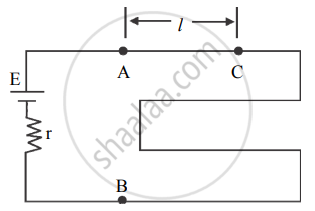
- When the circuit is switched on, the current I pass through the wire. Current through AC, I = `"E"/("R" + "r")` ….(1)
- Potential differences across AC,
VAC = IR
VAC = `"ER"/(("R" + "r"))` ….[From equation (1)] - Therefore, the potential difference per unit length of the wire is,
`"V"_"AC"/"L" = "ER"/("L"("R" + "r"))`
As long as E remains constant, `("V"_"AC")/"L"` will remain constant. - `("V"_"AC")/"L"` is known as a potential gradient along with AC and is denoted by K.
The potential gradient can be defined as a potential difference per unit length of wire.
APPEARS IN
संबंधित प्रश्न
Write two factors by which current sensitivity of a potentiometer can be increased.
In a potentiometer experiment, balancing length is found to be 120 cm for a cell E1 of emf 2V. What will be the balancing length for another cell E2 of emf 1.5V? (No other changes are made in the experiment.)
In the given circuit, with steady current, calculate the potential drop across the capacitor and the charge stored in it.

State the underlying principle of a potentiometer ?
Write two possible causes for one sided deflection in a potentiometer experiment.
The net resistance of an ammeter should be small to ensure that _______________ .
The net resistance of a voltmeter should be large to ensure that ______________ .
Draw a labelled circuit diagram of a potentiometer to measure the internal resistance ‘r’ of a cell. Write the working formula (derivation is not required).
A student uses the circuit diagram of a potentiometer as shown in the figure
(a) for a steady current I passing through the potentiometer wire, he gets a null point for the cell ε1. and not for ε2. Give the reason for this observation and suggest how this difficulty can be resolved.
(b) What is the function of resistance R used in the circuit? How will the change in its value affect the null point?
(c) How can the sensitivity of the potentiometer be increased?
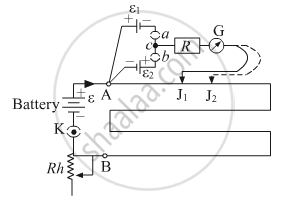
Define or describe a Potentiometer.
Define potential gradient of the potentiometer wire.
Distinguish between a potentiometer and a voltmeter.
A potentiometer wire has a length of 1.5 m and a resistance of 10 Ω. It is connected in series with the cell of emf 4 Volt and internal resistance 5 Ω. Calculate the potential drop per centimeter of the wire.
What will be the effect on the position of zero deflection if only the current flowing through the potentiometer wire is decreased?
When two cells of emf's E1 and E2 are connected in series so as to assist each other, their balancing length on a potentiometer wire is found to be 2.7 m. When the cells are connected in series so as to oppose each other, the balancing length is found to be 0.3 m. Compare the emf's of the two cells.
If the potential gradient of a wire decreases, then its length ______
A voltmeter has a resistance of 100 Ω. What will be its reading when it is connected across a cell of emf 6 V and internal resistance 20 Ω?
The resistance of the potentiometer wire should ideally be ____________.
The potentiometer is more sensitive, when ______.
The resistivity of potentiometer wire is 40 × 10-8 ohm - metre and its area of cross-section is 8 × 10-6 m2. If 0.2 ampere current is flowing through the wire, the potential gradient of the wire is ______.
Select the WRONG statement:
A potentiometer wire has length L For given cell of emf E, the balancing length is `"L"/3` from 3 the positive end of the wire. If the length of the potentiometer wire is increased by 50%, then for the same cell, the balance point is obtained at length.
A potentiometer wire of Length 10 m is connected in series with a battery. The e.m.f. of a cell balances against 250 cm Length of wire. If length of potentiometer wire is increased by 1 m, the new balancing length of wire will be ____________.
The length of a wire of a potentiometer is 100 cm, and the e.m.f of its standard cell is E volt. It is employed to measure the e.m.f of a battery whose internal resistance is 0.5 `Omega` If the balance point is obtained at `l`= 30 cm from the positive end, the e.m.f of the battery is ____________.
where 'i' is the current in the potentiometer
When two cells of e.m.f 1.5 V and 1.1 V connected in series are balanced on a potentiometer, the balancing length is 260 cm. The balancing length, when they are connected in opposition is (in cm) ____________.
A potentiometer wire of length 100 cm and resistance 3 `Omega` is connected in series with resistance of 8 `Omega` and an accumulator of 4 volt whose internal resistance is 1 `Omega`.
A potentiometer is used to measure the potential difference between A and B, the null point is obtained at 0.9 m. Now the potential difference between A and C is measured, the null point is obtained at 0.3 m. The ratio `E_2/E_1` is (E1 > E2) ______

A wire has a length of 2m and a resistance of 10Ω. It is connected in series with a resistance of 990Ω and a cell of e.m.f. 2V. The potential gradient along the wire will be ______
A potentiometer wire has a length of 4m and resistance of 5Ω. It is connected in series with 495 Ω resistance and a cell of e.m.f. 4V. The potential gradient along the wire is ______
In a potentiometer experiment when three cells A, B, C are connected in series the balancing length is found to be 740 cm. If A and B are connected in series, the balancing length is 440 cm and when B and C are connected in series, it is 540 cm. The e.m.f. of A, B, and C cells EA, EB, EC are respectively (in volt) ______
A potentiometer wire is 4 m long and a potential difference of 3 V is maintained between the ends. The e.m.f. of the cell which balances against a length of 100 cm of the potentiometer wire is ______
A potentiometer wire of length 'L' and a resistance 'r' are connected in series with a battery of E.M.F. 'E0' and a resistance 'r1'. A cell of unknown E.M.F, 'E' is balanced at a length 'ℓ' of the potentiometer wire. The unknown E.M.F. E is given by ______
In the potentiometer experiment, the balancing length with a cell E1 of unknown e.m.f. is 'ℓ1' cm. By shunting the cell with resistance R Ω, the balancing length becomes `ℓ_1/2` cm, the internal resistance (r) of a cell is ______
In the potentiometer experiment, cells of e.m.f. E1 and E2 are connected in series (E1 > E2). the balancing length is 64 cm of the wire. If the polarity of E2 is reversed, the balancing length becomes 32 cm. The ratio `E_1/E_2` is ______
The sensitivity of the potentiometer can be increased by ______.
A battery is connected with a potentiometer wire. The internal resistance of the battery is negligible. If the length of the potentiometer wire of the same material and radius is doubled then ______.
In the experiment of potentiometer, at balance point, there is no current in the ______.
Three resistance each of 4Ω are connected to from a triangle. The resistance b / w two terminal is
The value of current I in the network shown in fig.
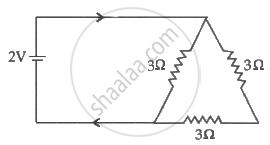
What is the current I in the circuit as show in fig.
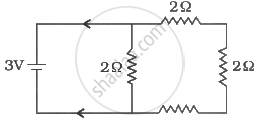
1°C rise in temperature is observed in a conductor by passing a certain current. If the current is double then the rise in temperature is approximately.
Consider a simple circuit shown in figure ![]() stands for a variable resistance R′. R′ can vary from R0 to infinity. r is internal resistance of the battery (r << R << R0).
stands for a variable resistance R′. R′ can vary from R0 to infinity. r is internal resistance of the battery (r << R << R0).
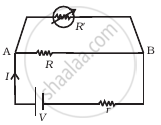
- Potential drop across AB is nearly constant as R ′ is varied.
- Current through R′ is nearly a constant as R ′ is varied.
- Current I depends sensitively on R′.
- `I ≥ V/(r + R)` always.
In an experiment with a potentiometer, VB = 10V. R is adjusted to be 50Ω (Figure). A student wanting to measure voltage E1 of a battery (approx. 8V) finds no null point possible. He then diminishes R to 10Ω and is able to locate the null point on the last (4th) segment of the potentiometer. Find the resistance of the potentiometer wire and potential drop per unit length across the wire in the second case.
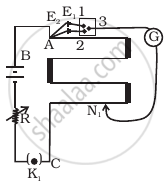
A Daniel cell is balanced on 125 cm lengths of a potentiometer wire. Now the cell is short circuited by a resistance 2 Ω and the balance is obtained at 100 cm. The internal resistance of the Daniel cell is ______.
If you are provided a set of resistances 2Ω, 4Ω, 6Ω and 8Ω. Connect these resistances so as to obtain an equivalent resistance of `46/3`Ω.
The emf of the cell of internal resistance 1.275 Ω balances against a length of 217 cm of a potentiometer wire. Find the balancing length when the cell is shunted by a resistance of 15 Ω.
What will a voltmeter of resistance 200 Ω read when connected across a cell of emf 2 V and internal resistance 2 Ω?
What should be the diameter of a soap bubble such that the excess pressure inside it is 51.2 Pa? [Surface tension of soap solution = 3.2 × 10−2 N/m]
Draw neat labelled diagram of potentiometer as voltage divider.
